#tekkamen
Explore tagged Tumblr posts
Text

Supra and Tekkamen @ Mount Haruna
#carsonfilm#japan#film#35mm#classic cars#bessa#jdm#wangan#touge#峠#touring#portra 160#kodak#toyota#supra#nissan#gt-r#r30#tekkamen#mount haruna#initial d#akina
231 notes
·
View notes
Text






DR30 Nissan Skyline RS-X
35 notes
·
View notes
Photo

Tekkamen na Kouhai
13 notes
·
View notes
Text
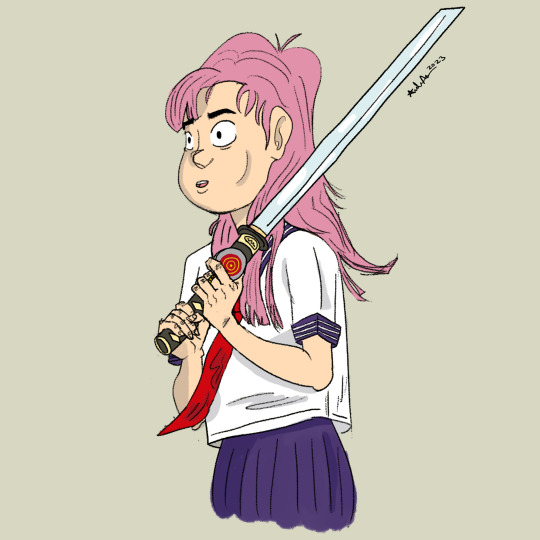
Saki (sketch 09052023)
#art#character design#character art#figure drawing#saki asamiya#Sukeban Deka#Yo-Yo Girl Cop#Sukeban Deka II: Shōjo Tekkamen Densetsu#seifuku#sword#yo-yo#pink hair#katana#cartoon#anime#artists on tumblr#illustrators on tumblr
4 notes
·
View notes
Photo
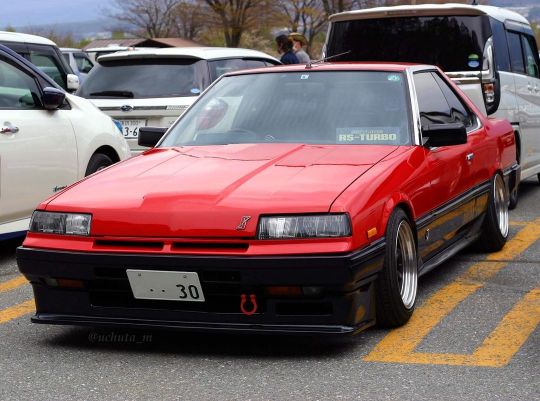
場外にいた鉄仮面‼️ #SkylineSaturday #R30 #DR30 #RsTurbo #Tekkamen #鉄仮面 #富士見自動車博覧会 (富士見パノラマリゾート) https://www.instagram.com/p/CQjs5y0s7uz/?utm_medium=tumblr
2 notes
·
View notes
Photo

Tekkamen DR30 Skyline RS-Turbo
3 notes
·
View notes
Photo

When people talk about classic Nissan Skylines, it’s usually R32/33 GT-Rs that dominate the conversation; or possibly the 1968-72 C10 “Hakosuka” or 1972/73 “Kenmeri” GT-Rs. But Nissan built millions of Skylines over the years, and many of them don’t get much attention. The R30 Skyline went on sale in the late summer of 1981, but the most special R30 was the DR30 RS - launched that October. Skylines, always family cars first and sporty cars second, were a little more sedate during the emissions-and-oil crises era, but the new RS was aimed at performance buyers. - Most of the classic performance skylines are six-cylinder cars, but the DR30 Skyline RS/RS-X were fours. The original 1981 RS was powered by an engine informed by the OPEC experience - Nissan’s four-cylinder FJ20E - the first four-valve-per-cylinder production engine in Japan. 4V layouts weren’t new became common in the #1980s, but Nissan was on the vanguard in 1981. The 150-hp 1,990-cc FJ20E, in naturally aspirated form, delivered slightly more power than the Skyline 2000 GT Turbo’s ~140-hp L20ET Six. The RS was also lightened and stripped of some creature comforts. - In February, 1983, the FJ20ET was born - now with over 190hp - making the #Skyline RS/RS-X turbos seriously hot machines for the time. Because of the car’s increased performance and profile, Nissan decided a few months later to give the DR30 a visual update that would match the increased punch and further differentiate the car from the other Skylines which, again, included diesel six hatchbacks for families. More than 400,000 R30s were made of all types, but the RS Turbo was a halo car. The visual update consisted of revised front styling that moved the air intake down low - the clean front earned it the name #Tekkamen (“Iron Mask”). There were also side skirts and graphics. - In 1984, an intercooler was added, which pushed the RS Turbo C to 205 hp. Sedans and coupes were available, RS-Xs had higher equipment levels than RS or RS Turbo Cs. In 1986, the R30 (which shared much with the C31 laurel) was replaced by the R31. The FJ20ET’s high manufacturing cost meant it was retired, to be replaced by RB20-series sixes in the hotter R31s. (at LeMay - America's Car Museum) https://www.instagram.com/p/B06Jf2clOMg/?igshid=gynwgkw38zkv
0 notes
Text


#asian horror#horror#japanese horror#japanese h0rror#mutant girls squad#Sentō Shōjo: Chi no Tekkamen Densetsu#戦闘少女 血の鉄仮面伝説#noboru iguchi#tak sakaguchi#yoshihiro nishimura
48 notes
·
View notes
Photo









Mutant Girls Squad - Sentô Shôjo: Chi No Tekkamen Densetsu – 戦闘少女 血の鉄仮面伝説 (2010) Directed by Tak Sakaguchi, Noboru Iguchi and Yoshihiro Nishimura
#Mutant Girls Squad#Yumi Sugimoto#Suzuka Morita#Gore#Film#Sentô Shôjo: Chi No Tekkamen Densetsu#Yoshihiro Nishimura
37 notes
·
View notes
Text
I wanna infodump about Sukeban Deka, specifically I wanna (ultimately) talk about a random bit of Sukeban Deka trivia I found out a few days ago that I find interesting.
OK so first: what is Sukeban Deka? Sukeban Deka is a franchise originally created by mangaka Shinji Wada. It's about a 17 year old incarcerated sukeban (female juvenile delinquent) named Saki Asamiya who basically gets blackmailed by the government and promised her freedom if she works as an undercover cop for them in order to infiltrate high schools and deal with youth and is given a yo-yo, which she uses as a weapon and also contains her badge identifying her as a member of the police.
The franchise began as a manga that was originally serialized in the shoujo magazine Hana to Yume from 1975 until 1982. The series originally concluded in January 1978 but, after the disappointing reception to Wada's new manga Pygmalio, Sukeban Deka resumed serialization in February 1979, which Wada regarded as 'Part 2' and was promoted as a new series in Hana to Yume, where it continued to run until coming to its final conclusion in 1982.
A few years after the conclusion of the manga, Toei and Fuji TV adapted Sukeban Deka into a live-action drama series starring idol singer Yuki Saito as Saki Asamiya. The series ran for 24 episodes from April to October 1985 and, because of its popularity, a second season of Sukeban Deka was commisioned.
The second season of Sukeban Deka, officially titled Sukeban Deka II: Shoujo Tekkamen Densetsu (Legend of the Iron Mask Girl), can be regarded as an entirely separate series from the first season, as Saito decided against returning to the role in order to focus on her singing career. Instead, Toei cast idol singer Yoko Minamino and, instead of pretending that Minamino (who obviously looks nothing like Saito) was the same character, turned the name of 'Saki Asamiya' from the characters actual name into a codename, with Minamino's character actually being named Yoko Godai and taking the codename of Saki Asamiya and becoming Sukeban Deka II.
Sukeban Deka II was much more popular than the first season and ran for 42 episodes from November 1985 to October 1986.
After Sukeban Deka II, Toei planned on airing a spin-off series entitled 'Sukeban Ninpucho', which would have focused around ninjas and have taken inspiration from the ninja movies of Sho Kosugi, Wada's own manga Ninja Flight, and Star Wars, with a proper Sukeban Deka III series airing after the conclusion of this spin-off.
However, for one reason or another, this didn't happen and Toei instead combined Sukeban Ninpucho and Sukeban Deka III into a single TV series: Sukeban Deka III: Shoujo Ninpojo Densetsu (Legend of the Girl Ninja Scroll). Just like with Sukeban Deka II, Sukeban Deka III featured a new actress as the main character: idol singer Yui Asaka as Yui Kazama (unlike Yoko Godai, Yui Kazama more often than not was referred to by her real name, rather than the Saki Asamiya name). The series also starred idol singers Yuka Onishi and Yuma Nakamura as Yui's sisters, Yuka and Yuma. Considering the origins of Sukeban Deka III, it ultimately had a much more fantasy bent compared to the urban crime themes of the previous two seasons and, because of these changes, while the series did run for its full-run of 42 episodes from October 1986 to October 1987, it ultimately didn't do too well in terms of audience reception (although the 9th episode of the series was the 8th highest rated episode of any Fuji TV drama series broadcast during the 1980s, with a rating of 21.3%). Original creator Shinji Wada was also critical of Sukeban Deka III, stating that they didn't understand why Sukeban Deka was the way that it was and that if they wanted to do a superhero program, they should have done it elsewhere. (It should also be noted that Wada was disappointed in the first series as well, as he thought it was too different from his vision, but he loved Sukeban Deka II and joked that he would've become a fan of it if it had aired when he was a student).
Meanwhile, during the broadcast of Sukeban Deka III, a movie version of the series was released in theatres in February 1987, simply entitled Sukeban Deka. While this film was released during the airing of the third series, it more serves as a sequel to Sukeban Deka II (as its set after the end of that series), although Yui Kazama also appears in the series.
A movie sequel to Sukeban Deka III was released in February 1988, entitled Sukeban Deka: Kazama San Shimai no Gyakushuu (Counterattack of the Kazama Sisters). In contrast to the TV series, Counterattack of the Kazama Sisters abandoned the fantasy elements and returned the series to the realistic drama and action that made it popular (well, as realistic as a series about a teenage detective who fights with a yo-yo can be).
I feel I also need to briefly mention Shoujo Commando Izumi here as well. Shoujo Commando Izumi is the series that replaced Sukeban Deka III in its timeslot and was originally planned as Sukeban Deka IV but was ultimately retooled into its own thing due to the negative reception to Sukeban Deka III. Unfortunately, Shoujo Commando Izumi was ultimately cancelled due to low ratings and only aired for 15 episodes from November 1987 until February 1988. (Shoujo Commando Izumi ultimately had an average audience rating of 7.12%, compared to a 13.98% average for Sukeban Deka III, 14.3% for Sukeban Deka II, and 13.04% for Sukeban Deka). (I can also, much more briefly, mention Hana no Asuka-gumi [The Glorious Asuka Gang], another sukeban series based on a manga that was produced by Toei and Fuji TV and aired for 23 episodes from April to September 1988. I only briefly mention this one as it was Toei and Fuji TV returning to the sukeban genre, but the series itself isn't at-all related to Sukeban Deka, beyond the genre, like Shoujo Commando Izumi was)
While there may be some debate over this, I personally consider the Sukeban Deka TV series and movies (as well as Shoujo Commando Izumi) to fall under the 'tokusatsu' label and I mean, there's also this:
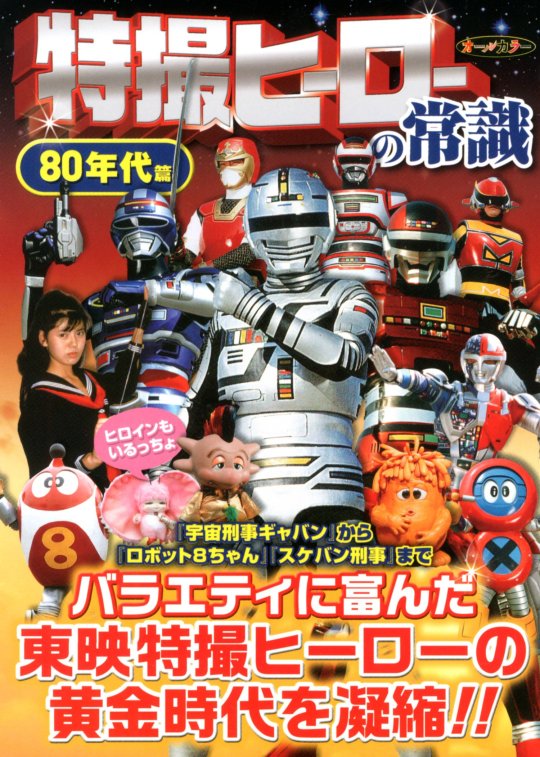
A book about tokusatsu heroes of the 1980s that features the second Saki Asamiya on the very front cover and covers the series within the book:

(Photo shamelessly stolen from this Mercari listing)
So I think it's fair to call it tokusatsu and I will continue to do so.
Anyways, since the conclusion of Sukeban Deka III in November 1987 and the release of Counterattack of the Kazama Sisters in February 1988, the series has had several releases and revivals, although it's nowhere near the level of popularity it was back in the 1980s.
In 1991, a two episode Sukeban Deka OVA was released that adapted the original story arc of the manga, with character designs based on Wada's original manga designs.
Wada also published two one-shot Sukeban Deka chapters set in a parallel universe in the shoujo magazine Melody in 1997 and 1998, two more chapters were published in 2003 in the seinen magazine Monthly Comic Flapper and all four chapters would be published as a tankobon and given the title Sukeban Deka If.
In 2006, Sukeban Deka would return to the big screen with the release of the film Sukeban Deka: Codename = Saki Asamiya, starring Aya Matsuura as K AKA the new Sukeban Deka. The movie also features Hiroyuki Nagato reprising his role as the Dark Director from the 1980s series and Yuki Saito as Saki's mother.
In 2021, ten years after Shinji Wada passed away due to ischaemic heart disease at the age of 61, three new Sukeban Deka series began serialization in the shoujo magazine Monthly Princess: - The Sukeban Deka Who Leapt Through Time - As far as I can tell, this series is about a girl in the modern day who ends up finding a mysterious yo-yo and ends up travelling back in time and having to work with the original Saki. This series began serialization in the February 2021 issue and is written and illustrated by Saori Muronaga - Re: Sukeban Deka - A straight remake of the original Sukeban Deka series with new art. This series began serialization in the March 2021 issue and is written and illustrated by Ashibi Fukui. - Sukeban Deka Pretend: A magical girl/henshin hero based take on the Sukeban Deka concept (and something I am 100% here for) This series began illustration in the September 2021 issue and is written by Sai Ihara and illustrated by Shingi Hosokawa.
If you want to read or watch any Sukeban Deka media, well you are somewhat in luck as several things from this series have been both officially and unofficially translated into English.
As far as official English Sukeban Deka releases go, the two 1980s movies were released by Media Blasters under their Tokyo Shock label in the mid-2000s, ADV released the 1991 OVA on video in 1996 (and later released it on DVD in 2003), and the 2006 film was released on DVD by Magnolia Pictures in 2007 under the title Yo-Yo Girl Cop (which should be noted is the official English name for the 2006 movie. You can easily find copies of all of these on eBay and other online sites (there's also rips of the 80s movies and 90s OVA on Nyaa, but no rip of the 2006 film - so you have to buy a copy of that if you want to see it [unless there's some other site that has a rip or upload of it, I haven't checked admittedly])
As far as unofficial English releases go: the first season of Sukeban Deka has two fansubbed releases: one by Skeweds Translations that is hardsubbed and was released in 2015 and an older softsub release translated by taroroot on D-Addicts in 2009 (unfortunately, I will admit to not having seen the TV series yet, so I can't say which version is better), Sukeban Deka II has been fansubbed by The Skaro Hunting Society, the original Sukeban Deka manga is (currently) being scanlated by HappyScans, with the most recent release being Chapters 23, 24, and 25 back in November. In addition, the two Sukeban Deka video games have also been translated into English.
As of right now, Sukeban Deka III has not been translated into English nor have any of the later spin-off manga been translated.
Now, to finally get to talking about the random bit of Sukeban Deka trivia I learned about recently: let's talk merchandise. During the time of the three Sukeban Deka TV series, the franchise was merchandised. It wasn't as heavily merchandised as other tokusatsu series were, but it still existed.
There were keshigomu figures (I've seen some things online refer to them as SD Sukeban Deka, but I can't find any actual products that label them with that name, so I assume it's just a fan nickname), a Sukeban Deka game (aptly called Sukeban Deka Game) that utilized these figures, a figure of Yoko Godai/Saki Asamiya II was released as part of the Lovely Gals Collection (a line of 1/6 scale figures that also included figures of Kei and Yuri from Dirty Pair and Yu Morisawa/Creamy Mami from Creamy Mami), and figures of Yui, Yuma, and Yuka Kazama from Sukeban Deka III were released part of the Pretty Idol Collection line (another line of 1/6 scale figures that, as far as I can tell from my research [googling the name of the line in Japanese], only consisted of these three figures). There also existed various model and garage kits (the garage kits, as well as the Pretty Idol Collection figures, were all released under Bandai's B-Club line, which was also the name of Bandai's model magazine).
In addition to these physical goods (as well as things like photo cards and albums considering these shows all starred idol singers in the main roles), there was also a Sukeban Deka II video game for the Sega Mark III and a Sukeban Deka III video game for the Famicom.
But there was one piece of merchandise that they didn't make, and it was the merchandise that anyone who even has a vague knowledge of Sukeban Deka would expect that they'd have made because it's the most obvious and would probably be the most popular merch too: they never made merchandise off of Saki's yo-yo.
That's right, despite it being the most iconic element of the entire franchise, there were no Sukeban Deka yo-yo toys released during the 1980s.
Why is that? The answer is simple: Shinji Wada thought that it would be too dangerous because kids would likely try and copy the moves they saw Saki doing with the yo-yo on the TV series and might hurt themselves.
Now, that's not to say there were no officially licensed Sukeban Deka yo-yos at the time, but the two licensed yo-yos were both model kits one by General Products and the other by Bandai.
But if you wanted a full-size Sukeban Deka yo-yo back in the 80s? Well, other companies obviously knew about the series' popularity and wanted to capitalize on the trend, so bootlegs galore:
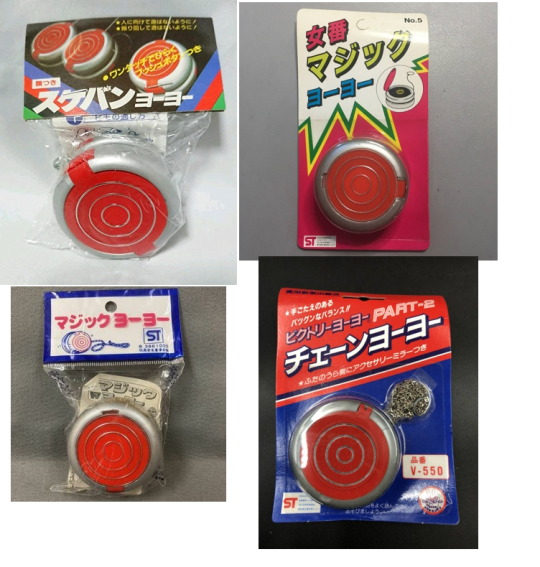
(I just shamelessly stole these pics off various Japanese auction site listings and there's obviously tons more bootleg Sukeban Deka yo-yos from the 1980s than just these four)
Eventually, after years of fans clamoring for an official Sukeban Deka yo-yo (even with the end of the TV dramas and the sukeban genre boom), Bandai finally gave fans what they'd been asking for for years.
In 2006, with Shinji Wada's approval, Bandai released two official Sukeban Deka yo-yos, in time for the release of the Codename = Saki Asamiya film.
The first yo-yo, released in October 2006, was this one:
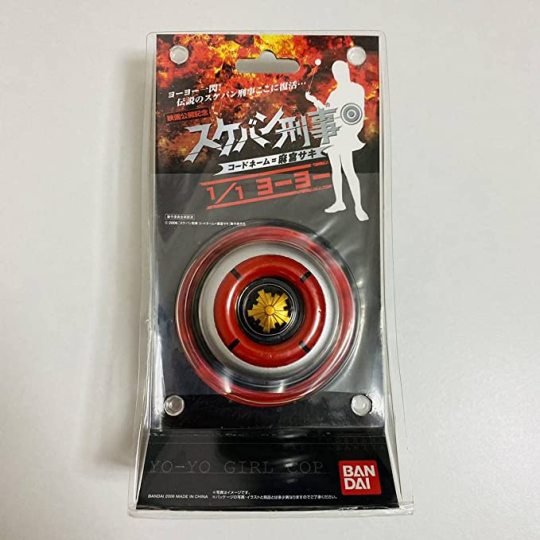
Sukeban Deka Codename = Saki Asamiya 1/1 Yo-Yo, which was obviously modeled after the yo-yo used in the 2006 movie.
The second yo-yo, released in November 2006, was this one:
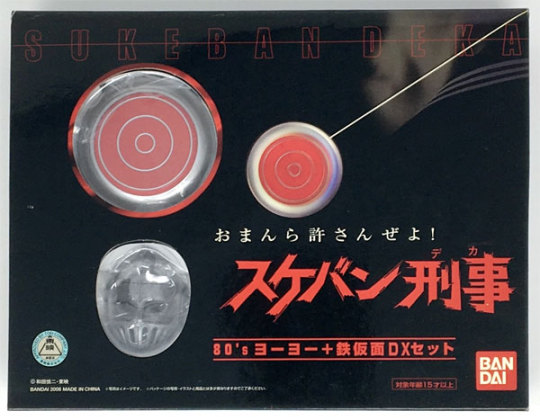
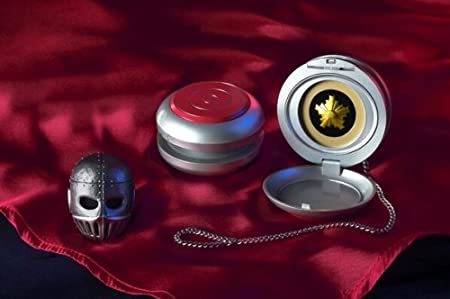
Sukeban Deka 80's Yo-Yo + Iron Mask Deluxe Set, which included two yo-yos (a metal yo-yo meant as a display piece [the yo-yo in the series is made of metal] and a plastic yo-yo that can be used as an actual yo-yo) and a 1/6 size replica of the iron mask worn by Yoko Godai in Sukeban Deka II.
Unfortunately, if you want to buy these on the aftermarket, well you're in luck if you want the 2006 yo-yo! I've seen that sell online for anywhere from the equivalent of $20-30 (for the record, it retailed for ¥2090).
But if you want the 80s yo-yo set? Yeah that set easily goes for $150+ dollars nowadays (and on US eBay, people want $300 for it) (for context, it retailed for ¥5500).
And so that's it, that's the random Sukeban Deka fact that I learned recently that I found interesting: they didn't release a full-size Sukeban Deka yo-yo, despite it being the most iconic element of the series, during the 1980s when the franchise was at its most popular because original creator didn't want kids to get hurt, but they then finally released one over 20 years later in 2006 because of the new live-action movie.
(Maybe in the future if they ever do something with the Sukeban Deka franchise beyond those spin-off manga, Bandai [or some other company] will release new Sukeban Deka yo-yos)
#text post#sukeban deka#tokusatsu#toku#infodump#infodumping#wow can y'all guess what one of my special interests is#(it's this series)#long post
4 notes
·
View notes
Text
Super Robot Wars W Stream at 7:30 CST! Well fuck Tekkaman Blade's been arrested because Earth Union is a fuck, The Sol Tekkamen are dead except Balzak (Whomst is also a fuck), and in general Great Googly Moogly it's all gone to shit!
2 notes
·
View notes
Text

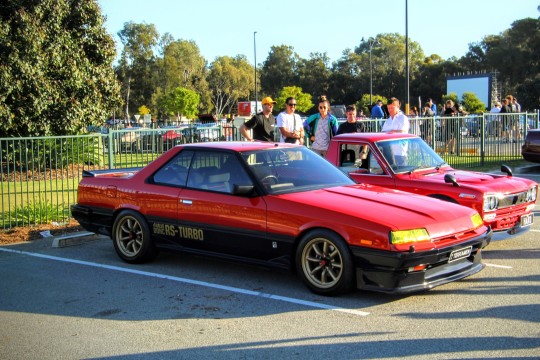
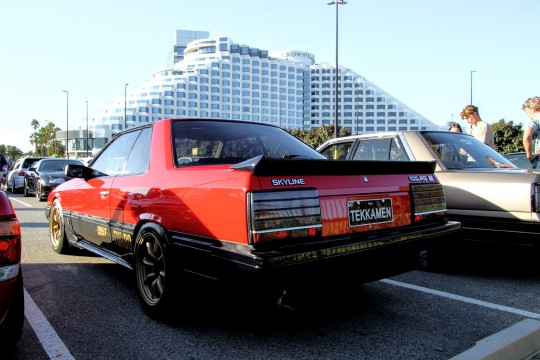


DR30 RS Turbo Skyline
Tekkamen plates are because that is the Japanese nickname for these. Translates as Iron Mask.
49 notes
·
View notes
Text
Space Cyborgs
In the depths of space, the fusion of biology and technology often results in horrors...

Recovering Cyberman (4-Point Quality) The Cybermen, also known as the Borg, are one of the most dangerous species in the galactic cluster. They are, simultaneously, the worst parts of communism and capitalism. On one hand, the individual is completely subservient to the state ("The Collective"). On the other, they consume everything and everyone in their path. And the worst part of all that is, they genuinely believe they are helping others when they "Upgrade" them. But some manage to escape the living hell of being a cog in the machine. One way or another, people have recovered from being cybernetically altered by Cybermen. However, sometimes those rescued from the Cybermen cannot have all their technological components removed easily. This leaves them in this half-state of being returned to normal, but still visibly and technically Cybermen. They start out with the Robot quality, however, they can recover 1/2 their life points from normal healing roles. The rest needs to be 'repaired'. Other cybernetic enhancements (See All Tomorrows Zombies for some examples, as well as other various powers depending on how they are justified) can be applied to the Recovering Cyberman. They all start with Data Jack, allowing them to connect with machines directly. However, they don't need a proper interface to do so. Any "Port" in a machine will serve their needs. They can gain more abilities over time. However, the more 'abilities' they have, the less human they look. Even with mostly human appearances, they have little signs that they were once encased in metal.
They have Attractiveness -1 (and can get worse if more 'bits' are added). Their time in the hive mind Collective has rendered them cold and distant emotionally. This saddles them with the 1 Point Emotionless drawback. Finally, because the Cybermen are so hated (and the Cybermen themselves are kinda, sorta massive jerks), they have Adversary 4 from both the Cybermen themselves and their victims who see Recovering Cybermen as an easy target for their revenge.

Tekkaman (40-Point Base Quality)
In deep space, there are horrible space-born monstrosities. Heterodyne, Crystalline Entities, Great Old Ones, and the Uchuu Kaiju, also known as the Dholes.
The Dhole reproductive cycle is a parasitoid one on a planetary scale. To find hosts for their offspring, they have the Pretenders. Parasitoiding a Cybertronian colony world apparently gave them the idea of creating the "Pretenders" of their own.
youtube
Tekkamen are the heralds and scouts of the Dholes, part of their organic systems to find inhabited planets for them to reproduce in. They are relentless, cruel, and often weaken the defenses of any civilization the Dholes wish to consume directly. Think of them as 'cells' in a sponge, as much part of the whole as a living thing unto itself.
But some manage to escape the thralldom of the Dholes. They often work to fight off the Dholes and prevent them from parasitizing planets.
These free Tekkamen look and act like normal members of their species, but can transform into their Tekkaman form. In this form, they gain +5 Strength, +4 Dexterity, +3 Constitution. They have an Armor Value of 15, which doubled against Direct Energy Weapons (Beam, Plasma, Fire, Electricity), are Vacuum Sealed, and have Advanced Flight capabilities.
On the negative side, even though they are reformed, they have a lot of enemies. Those looking to exploit them and their power, as well as their former Dhole masters and their Tekkamen. This counts as Adversary 5. They have the Dual Form drawback, and in their Tekkaman form they are rather scary (even when heroic), having -2 Attractiveness. Tekkamen can only maintain the shape for 30 minutes each day, limiting what they can do. Each 'hour' un transformed restores 1 minute of the transformation. They also need an object to trigger their transformation. Sometimes it's a crystal, other times it's a bulky machine they must step into to change.
Tekkamen have blades that grow from their bodies. The Blades are usually either two 3 x Strength Slash/Stab damage or one 5 x Strength Slash/Stab weapon. These are both AP 5 to fight the foes of the Dholes. Some have both weapons, but this increases the cost of the quality by 16.
But some Tekkamen have more abilities than that. Primarily, the powerful Voltekka. The Voltekka is a powerful blast of plasma energy, dealing 100 Plasma damage. This adds 46 points to the total quality.
youtube
Tekkamen are very good at defending themselves.
2 notes
·
View notes
Photo

The Three Musketeers
Genre : adventure, romance, historical, comedy, drama
Category : Special / Аnime series / Аnime film
Episodes : (Tekkamen o Oe "d'Artagnan Monogatari" yori) 25 min / (Anime Sanjuushi) 52 duration 25 min / (Anime Sanjuushi: Aramis no Bouken) 46 min
#The Three Musketeers#Anime Sanjuushi#Aramis no Bouken#anime#retro anime#special#anime series#anime film#anime 80s#anime adventure#anime romance#anime historical#anime comedy#anime drama
27 notes
·
View notes
Text

A short comic inspired by the old Japanese media franchise called “Sukeban Deka”,
(Here’s a short blog post about the franchise, if you’re curious kayokyokuplus.blogspot.com/201…). It is loosely based on both the ‘80s show Sukeban Deka ll: Shoujo Tekkamen Densetsu [スケバン刑事II 少女鉄仮面伝説] and the 1987 movie “Sukeban Deka” [スケバン刑事], in particular
Panel 1: Yoko Godai, a native of the Kansai Region town of Tosa, was once an orphan who lost her parents at a very young age. Ever since kindergarten she was often bullied by a bunch of sadistic classmates who forced her to wear an iron mask at the age of 8. Despite being very uncomfortable on her head, as well as being the main source of mockery for all the students at the school she attends, the mask somehow gives the girl supernatural physical strength, hardens her resolve to fight others who stand in her way, and slowly turns her into a cold-hearted sociopath. Some crazy local businessmen from the criminal underworld manage to take advantage of Yoko’s fighting skills, honed from constant brawls at school, and pit her against a few professional wrestlers, and once she triumphs in all the matches, the businessmen seek a way to prove that “The Girl with the Iron Mask” who causes constant mayhem for her fellow students and teachers is indeed the single greatest fighting champion of the town of Tosa. So they decide to pit the girl against a powerful Tosa Inu (pictured) who once earned a legendary reputation for winning every single dog fight without sustaining any scars or injuries. In a single match, she happens to tackle the dog head on with her bare hands and eventually kill it after a long, gruesome fight.
Panel ll: The Girl with the Iron Mask continues to remain a deeply troubled fellow who often gets involved in fights at school and terrorizes everyone around her. One day she gets hunted down by the police and is imprisoned in an immense juvenile detention facility (operated by a sadistic ex-JGSDF soldier known as Hattori) built with maximum-security features, along with a large bunch of other juvenile delinquents, whom she happens to subdue in a series of brawls held every night at prison. It is through winning those fights that Yoko gains the trust of her fellow prisoners and earns her reputation among them as a tough, stoic girl gang leader with a cold-blooded personality and no remorse for insubordination among her peers. Yoko soon devises a plan to liberate everyone from the juvenile detention facility and demand that the Japanese government should provide better, humane treatment for mentally insane school students like her. So one night, Yoko and her comrades successfully stage a prison escape (pictured) and, once they become national fugitives on the run, Hattori and his minions launch a full-scale operation to locate the girls and kill them all, whilst he takes advantage of the general public’s fears of Yoko Godai as a cold-hearted monster on the loose with the use of a brilliant propaganda campaign; Through posters, loudspeakers mounted on moving vans, and radio/TV PSAs, Hattori promises a reward of one million yen for anyone who takes part in capturing her or bringing her back to him alive.
Panel lll: Nishiwaki, Assistant Director of the Japan National Police Agency’s top-secret “Sukeban Deka Project”, which is based in Tokyo, catches Yoko Godai on the orders of Director Toshiro Yamamoto. He removes her iron mask, and offers her an opportunity (pictured) to take the name and role of Saki Asamiya a legendary crime-fighting schoolgirl of the 1970s who once was the first “Sukeban Deka” or “Delinquent Girl Detective.” She was killed by nuclear radiation after she tried to rescue her fellow students from a nuclear accident caused by an unknown, high-ranking villain. Yoko initially refuses the offer at first, but changes her mind once Nishiwaki promises that he would help her find her missing parents in exchange for her service.
Panel lV: So after a single week of intensive crime-fighting training, Yoko Godai is given the alias of “Saki Asamiya” in honor of the first Sukeban Deka, assumes her place as “Sukeban Deka No. 2”, and is given the same powerful red-colored steel yo-yo which was Saki’s trademark weapon of choice. As an undercover police agent, Saki Asamiya soon recruits two other crimefighting schoolgirls who join her cause: The Osaka native Kyoko Nakamura and the Kyoto native Yukino Yajima. Together the three girls would fight a wide assortment of villains such as youth gang leaders and other strange criminals. In one instance Saki vanquishes two Mohawk-wearing Chicano-wannabes who were cocaine lords with the use of her yo-yo (pictured). Saki and her friends also defeat the nefarious Hattori and his scheming minions and bring them all to justice.
Panel V: At the end of each day spent on fighting the villains and bringing them to justice, the three Sukeban girls would go on short, pleasant trips together in and around the city. Here they are watching a sunset on the outskirts of a few suburbs (pictured).
4 notes
·
View notes
